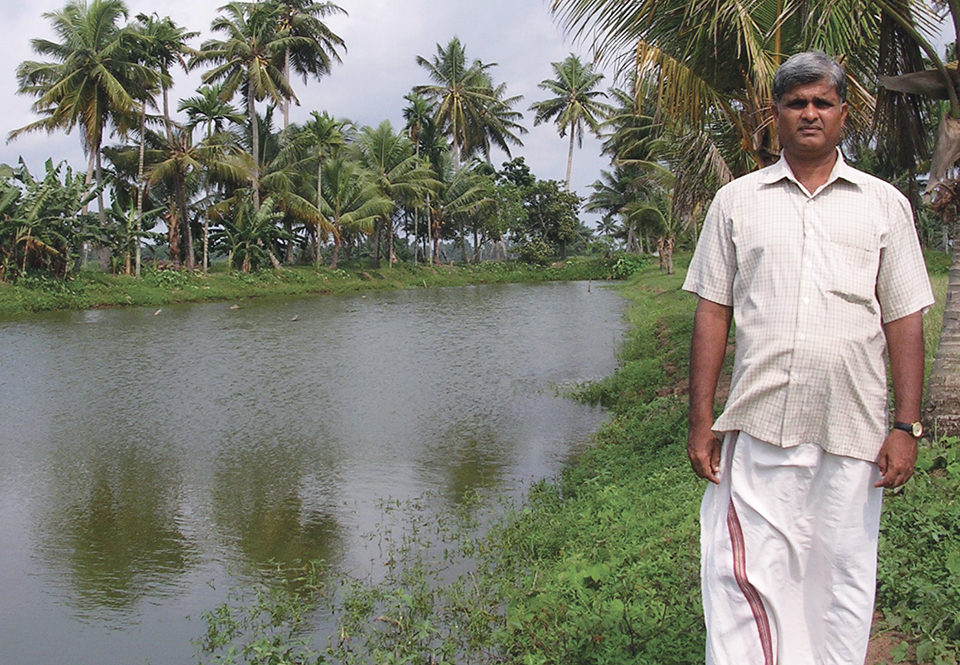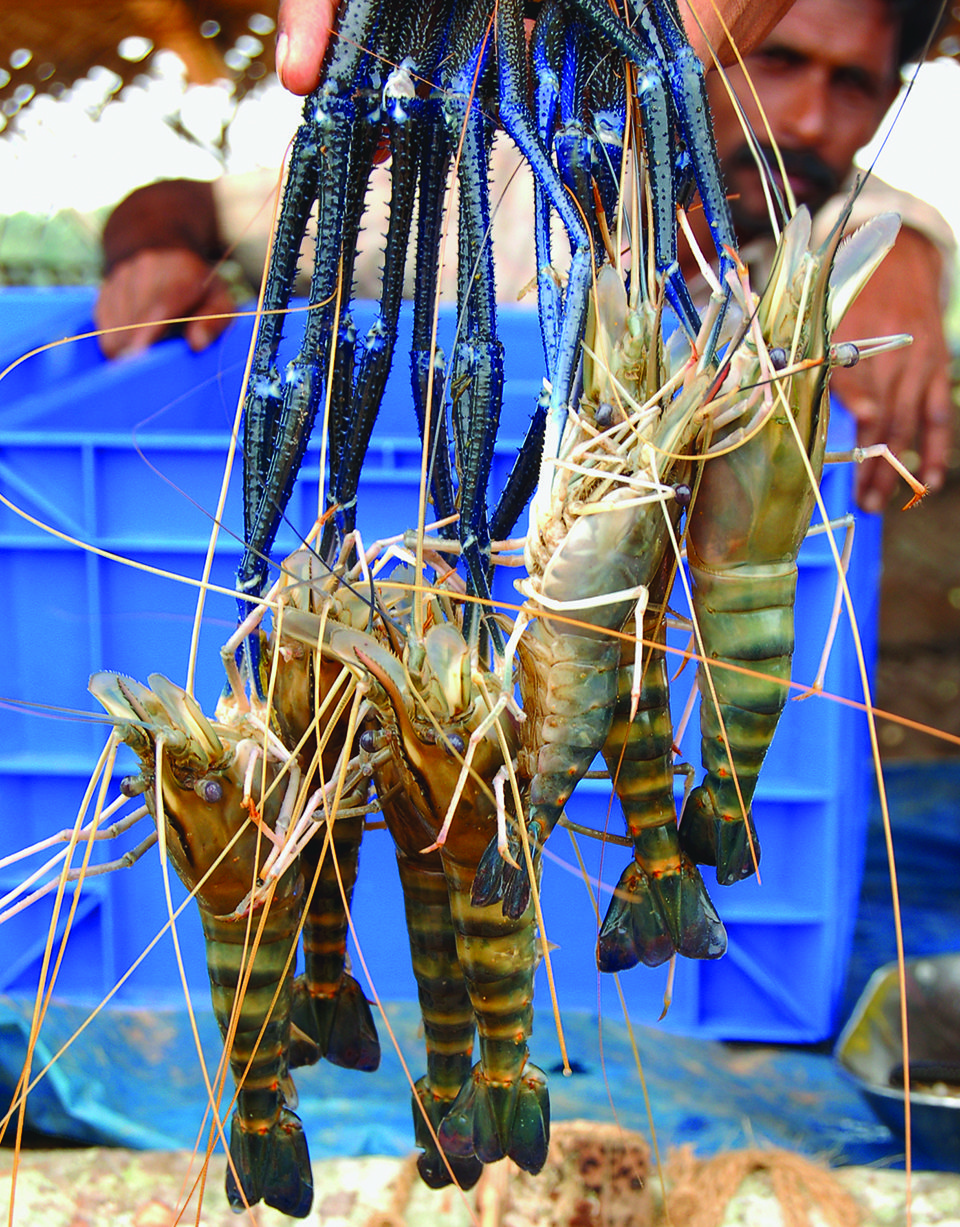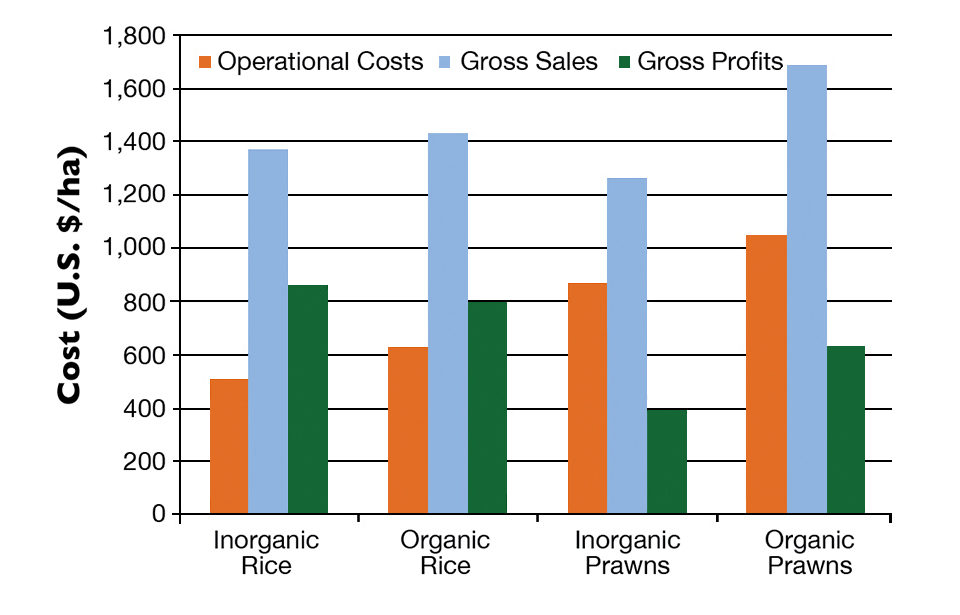India is the second-largest producer of giant freshwater prawns

The 1,150-square-kilometer area of Kuttanad in Kerala, India, is a typical flooded wetland system where intensive cultivation of rice is carried out, and so is known as the rice bowl of Kerala. Fish and prawn rotational culture systems have been introduced in Kuttanad as a means to augment farm income and obviate environmental degradation. This rice-fish farming reduces the use of toxic chemicals and substantially reduces labor costs for paddy cultivation, making it an economical and eco-friendly enterprise.
The paddy fields of Kuttanad and Kole in Kerala are classic instances of the success of such integration. The introduction of the giant freshwater prawn (Macrobrachium rosenbergii) in paddy fields stocked after one crop of paddy has further boosted the prospects of this system. Interestingly, in the rice fields, prawns are a secondary crop, and when considered separately, the profitability of prawns in the rotational rice fields would normally be low, especially in light of the increased selling price of rice.
Rice-fish/prawn rotational farming
Traditional small ponds of 3 hectares (ha) or less in Kuttanad annually yield up to 750 kg of freshwater prawns when stocked at 20,000 per ha, and up to 1,000 kg of fish per ha, mostly weed-eating grass carp stocked at 1,500 per ha. The harvests fetch an average additional profit of up to U.S. $1,350 per ha, and also save on chemical applications and labor for rice cultivation in the small fields. Larger fields of up to 50-ha area yield up to 350 kg of prawns and 950 kg of fish per ha, fetching a gross profit of $450 to 490 per ha.
Inorganic rice yields typically range 5,000 to 5,500 kg per ha with gross profits of $850 to 900 per ha. Rice-fish-prawn integration yields 298 percent more income in bigger paddy fields as compared to monoculture of rice. In fact, the profitability of inorganic rice has greatly increased lately, as there has been a 47 percent rise in the paddy procurement price in Kuttanad.
Organic trials
The first trials of organic farming of freshwater prawns were carried out in Kuttanad in 2008 after almost three years of field experimentation with organic paddy production in the same fields. The initiative for the India Organic Aquaculture Project (IOAP) was by the Marine Products Export Development Authority (MPEDA) of India jointly with the State Secretariat for Economic Affairs of Switzerland. It adopted organic prawn-farming standards from Naturland Germany and Indocert, the local certification agency. Through farm inspections at different stages of production, Naturland ensures that the guidelines are properly followed.
Successful organic paddy farmers were initially certified as transitional farmers, and in the third crop were given the status of full organic certification. These farmers were engaged in a buy-back arrangement with a processor who agreed to pay a 20 percent price premium over prevailing market rates for the organic prawn harvest. Among those who attempted organic cultivation, only three farmers with a total farm area of 9 ha received organic certification for both rice and prawns.
Inorganic and organic paddy and prawn production in these fields were compared, and the production economics were worked out for comparison. Despite slight reductions in rice production and the higher costs involved in organic farming, the organic approach brought significant advantages with respect to economic returns and obvious environmental and social impacts.

First prawn harvests
Results from the organic farming of paddy and prawns have been encouraging, and many new farmers are coming forward to participate. As part of the IOAP, 340,000 certified organic prawn seeds from a local hatchery were stocked in three organic paddy-prawn fields of 9 ha total area, producing average yields of 392 kg per ha of prawns and 50 kg per ha of fish. At the three farms, the postlarvae were initially stocked in a nursery and released to the grow-out fields after 60 days. Organic feed manufactured in Chennai and certified by Naturland Germany was used throughout the nursery and growout periods.
The total prawn harvest was 3.5 metric tons (MT) from the three farms. In the paddy fields of Kuttanad, partial harvesting is often difficult because of the extensive nature of the paddy fields, where dewatering by pumping is expensive and time consuming.
However, the first organic farming trials in Andhra Pradesh are being carried out by two farmers societies comprising about 25 farms and an area of 30 ha, where a higher yield of up to 800 kg per ha is expected. This higher yield is based on the first cull harvest completed. The prawn farms in Andhra Pradesh are more manageable and could boost organic prawn production through the participation of more active farmers.
Productivity, profits
Although rice productivity was found to decrease by about 23 percent under organic farming, it was almost fully offset by a 5 percent increase in gross income benefited by the 36 percent higher premium price obtained for organic rice, although there has been a marginal 7 percent reduction in gross profit because of the greater expenses incurred in organic paddy farming (Fig. 1).

However, the organic prawn yield fetches more income than the inorganic prawn crop. The price of organic prawns is greater by 20 to 30 percent, yielding a 34 percent increase in gross income and 63 percent increase in gross profit when compared to conventional prawn yields. Overall, there has been a 15 percent greater cumulative profit when organic paddy-prawn culture is done in rotation, as compared to inorganic paddy-prawn production.
Transitional phases
In the first phase of the IOAP project, only the two states of Kerala and Andhra Pradesh were included. The feasibility of extending the project to other Indian states is being explored by MPEDA.
In Kuttanad, where organic paddy and prawn productions are linked, the paddy crop is certified first and accorded the status of a conversion period during which the organic farming standards are first applied to a field as directed by the certifying agencies. This phase marks a gradual transformation of the fields – many of which may have used chemicals, pesticides and inorganic fertilizers over the years – to an organic realm that abstains from all such chemicals. During this time, farmers train themselves in the use of organic inputs based on a system of integrated pest and nutrient management to harvest the first crop of paddy in the transitional phase.
In the second year, more-confident farmers apply the organic farming standards fully and produce first crops of organic rice, which may be certified if they fully satisfy the standards conditions. Organic prawn production is also in the transitional stages during this phase.
Only in the third year can prawn farming be certified organic if the facility fully satisfies the IOAP guidelines. Such adherence to the standards is ensured in the projects initiated by frequent visits by technical staff from Indocert and based on culture data maintained by the farmers.
Maintenance of proper culture records in the farmers’ diaries is a mandatory requirement in the project. Utilizing the Internal Control System, day-to-day farm activities are diligently recorded by farmers and closely monitored by a panel of field inspectors. This effectively ensures that organic farming principles are properly followed throughout the culture period.
Marketing of the organic prawns is based on a contract with the certified processor who agreed to purchase the product. This has twin advantages for the farmers, who get a better price and avoid any marketing middlemen.
Perspectives
Great progress has been achieved in giant freshwater prawn farming, especially since 2000. The present annual production and farm-gate values exceed 400,000 MT and $1.75 billion, respectively.
China has been the leading producer of freshwater prawns for some time – with 304,552 MT in 2006, while India, the second-largest producer, produced only 30,150 MT. This new initiative, the first of its kind in India, could become a model for sustainable prawn-farming systems in the rest of the world. Organic farming carries immense potential for development in other Asian countries. However, further trials to bring down operational costs and increase the profitability of organic prawn production should also be done.
(Editor’s Note: This article was originally published in the November/December 2009 print edition of the Global Aquaculture Advocate.)
Now that you've finished reading the article ...
… we hope you’ll consider supporting our mission to document the evolution of the global aquaculture industry and share our vast network of contributors’ expansive knowledge every week.
By becoming a Global Seafood Alliance member, you’re ensuring that all of the pre-competitive work we do through member benefits, resources and events can continue. Individual membership costs just $50 a year. GSA individual and corporate members receive complimentary access to a series of GOAL virtual events beginning in April. Join now.
Not a GSA member? Join us.
Authors
-
C. Mohanakumaran Nair, Ph.D.
College of Fisheries
Kerala Agricultural University
Panangad P.O.
Kochi 682 506
Kerala, India[109,111,99,46,108,105,97,109,116,111,104,64,109,99,114,105,97,110]
-
K.R. Salin, Ph.D.
College of Fisheries
Kerala Agricultural University
Panangad P.O.
Kochi 682 506
Kerala, India
Related Posts

Health & Welfare
A holistic management approach to EMS
Early Mortality Syndrome has devastated farmed shrimp in Asia and Latin America. With better understanding of the pathogen and the development and improvement of novel strategies, shrimp farmers are now able to better manage the disease.

Intelligence
A land grab for salmon (and shrimp) in upstate New York
The operators of Hudson Valley Fish Farm see their inland locale as a pilot to prove that land-based fish farming, located in close proximity to major metropolitan markets, can be successful.

Responsibility
A look at integrated multi-trophic aquaculture
In integrated multi-trophic aquaculture, farmers combine the cultivation of fed species such as finfish or shrimp with extractive seaweeds, aquatic plants and shellfish and other invertebrates that recapture organic and inorganic particulate nutrients for their growth.

Aquafeeds
A look at protease enzymes in crustacean nutrition
Food digestion involves digestive enzymes to break down polymeric macromolecules and facilitate nutrient absorption. Enzyme supplementation in aquafeeds is a major alternative to improve feed quality and nutrient digestibility, gut health, compensate digestive enzymes when needed, and may also improve immune responses.


